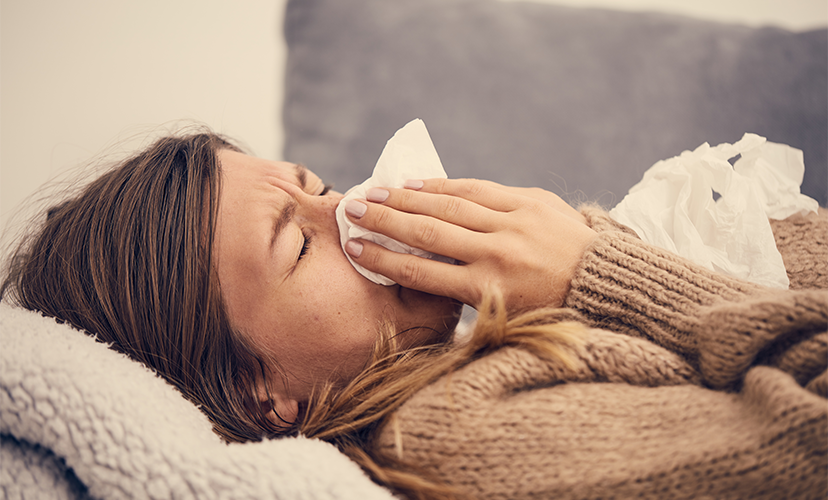Fact Checked
Intus Healthcare’s writers, customer service team, and sleep experts review and ensure this information is accurate.
Last updated on March 31st, 2025 at 11:13 am
Allergic rhinitis fatigue is closely linked to Sleep Apnoea; as the weather changes, you may experience an increase in your Sleep Apnoea symptoms due to allergies.
This article will examine the link between seasonal allergies and provide symptoms and solutions.
Table of Contents
What is Allergic Rhinitis Fatigue?
Allergies can cause uncomfortable reactions in sufferers, including fatigue and typically affects the nasal and sinus passages. Clinically termed Allergic Rhinitis, the adverse reactions are caused by breathing in allergens. Some of these allergens are seasonal, but others can affect sufferers all year round.
Allergic Rhinitis, or Hay fever, is a common seasonal condition for those allergic to pollen. However, mould, mildew, dust mites, smoke and chemicals in household products can also cause an allergic reaction. It causes an inflammatory response, and sufferers can experience various symptoms from sneezing, itchy nose or eyes, swelling and excess mucus production. Another outcome of Allergic Rhinitis can often be a lack of sleep and the subsequent fatigue this brings.
Those with more severe symptoms tend to suffer worse from sleep deprivation issues. Studies indicate those who suffer from Allergic Rhinitis are at higher risks of nocturnal dysfunctions, including insomnia, restless sleep, sleep-disordered breathing, Obstructive Sleep Apnoea and snoring(1).
Allergic Rhinitis Fatgiue and The Link to Sleep Apnoea
Can lack of sleep cause Allergic Rhinitis? Research has linked Allergic Rhinitis to Sleep Apnoea, a debilitating disorder that can lead to serious health problems if untreated.
The most common form of Sleep Apnoea is Obstructive Sleep Apnoea (OSA), where sufferers experience frequent interruptions to their sleep during the night due to their airways narrowing and becoming blocked. The obstruction causes breathing pauses, and as the brain reacts to the drop in oxygen, the sufferer commonly wakes up gasping for air.
Symptoms of OSA include:
Can Allergic Rhinitis Cause Sleep Apnoea?
Nasal congestion from Allergic Rhinitis narrows the airways and can increase the risk of OSA. This can increase the risk of accidents at home and work, with drowsiness making you up to five times more likely to have an accident while driving(2).
OSA has also been found to be linked to several severe health conditions, including:
- Heart disease
- High blood pressure
- Stroke
- Type 2 diabetes
- Liver damage
- Depression and Anxiety
Many individuals may remain undiagnosed for their allergies. Nonetheless, even for those who have been diagnosed and are following prescribed allergy treatments, there exist various practical methods to proactively minimize exposure to allergens. Poor indoor air quality can lead to the presence of pollutants triggering allergic responses.
Self-Help for Allergy Sufferers
Here are some things you can do and devices to use to help your allergies:
- Closing your windows at night can minimise pollen levels in the morning. Pollen can be carried into the house as well as blown in. You may want to change your clothes if you have been out, as pollen can collect on the fibres.
- If you hang your washing out to dry in the garden, you will bring pollen into the house. Tip – Shower before bed to remove any pollen which may have been collected on your skin or hair throughout the day.
- Choose non-drowsy allergy medications, which can make you feel tired and unmotivated.
- Dehumidifiers can help reduce the presence of mould and mildew in a damp house, which can result in an allergic reaction. If you have air conditioning in your home, use HEPA (high-efficiency particulate air) filters and replace the filters regularly.
- Nasal irrigation is excellent for allergies and sinus issues, as it helps clear blockages. The salt reduces inflammation and promotes healing. We recommend the SinuPulse Elite Nasal irrigation system or the simple SinuAir nasal spray; the applicator uses salt powder to cleanse your nasal passages and relieve congestion. Whichever you go for, both remove nasal irritants, relieving itchiness and excess mucous.
- Removing Dust Mites can also help your allergies. Hard internal surfaces like wood flooring are better than carpets for decreasing dust mite numbers. If you prefer carpet, make sure to vacuum clean regularly, preferably with an appliance fitted with a HEPA filter, as it traps more dust mites than regular vacuum cleaners. Regularly vacuum or wash soft furnishings and wipe down your hard surfaces. You should use household cleaning products containing natural, hypoallergenic ingredients. If you are struggling for time to clean everywhere, make sure you concentrate on the areas where allergy sufferers spend the most time. Take a little time to think carefully about new items you buy for your home. Choose furniture styles other than upholstered and fit roller blinds, which are easier to wipe clean. Buy allergy-proof mattresses and bedding covers. All these preventative methods can help keep dust mite numbers down and reduce the potential for allergens.
- Drink plenty of water daily to keep secretions loose, making them easier to remove.
- Use a menthol humidifier to help keep the sinuses open.
- While you sleep, you should elevate the head of your bed slightly to help keep your airways open.
- Avoiding smoking will help prevent symptoms; wood burners can also be an issue, so look for a gas fire instead.
Of course, it is not just ourselves and our homes which are hosts to allergens; our pets are too. The dead skin cells and saliva can contain allergens, which may cause allergic reactions.
If you have pets, you need to be more attentive to their grooming and try to do it outdoors. You should wash their bedding and where they lay at least once a week. Try to limit their access to certain rooms, including the bedroom. Use air filters and look to improve ventilation in spaces they occupy.
Sleep Apnoea & Allergies
If you suffer from Obstructive Sleep Apnoea, there are a few things you can do to protect yourself from allergies.
CPAP cleaning: Regularly cleaning your equipment is recommended to prolong its lifespan and ensure you can continue using it safely. Cleaning your equipment removes bacteria, dust and microbes to reduce the risk of getting sick.
There are a variety of products designed specifically for your CPAP; some you can try include:
The SoClean 2 CPAP Sanitiser
If you use CPAP equipment to treat your Sleep Apnoea, consider adding the SoClean 2. The SoClean 2 kills 99.9% of bacteria in a CPAP machine, mask and humidifier tub, reducing the risk of air-borne infections.
CPAP Soap
This soap is safe to use with your equipment; it quickly removes dirt from your mask and machine.
CPAP mask wipes
These wipes are ideal for quickly removing facial oils and bacteria from your mask cushion, headgear and other parts. Many people use these while travelling as they are easy to pack, taking up just a small amount of room.
CPAP humidification: Adding a humidifier to your CPAP therapy will moisten the airflow you receive from your machine, making breathing more comfortable. Add a heated hose to keep the airflow warm throughout the night.
CPAP Pillows: Elevating your head at night can help reduce airway obstructions and prevent snoring. A CPAP pillow lets you sleep on your side and open your airways comfortably.
In-Home Test For Sleep Apnoea
Allergic Rhinitis Fatigue has been found to be linked with OSA, and many people with OSA are unaware they have the sleep disorder. Confirming the diagnosis is critical so you can receive the correct treatment, reduce symptoms and lower the risk of developing other severe health issues.
Some symptoms of Sleep Apnoea can be challenging to recognise at first, as you might not recall waking up during the night. It can often be a partner who sees the signs first, but once you think you may be affected by Sleep Apnoea, it is crucial to test for the condition. You can do this quickly and easily with an In-Home Test for Sleep Apnoea.

Home Sleep Apnoea Test
The test monitors your heart rate, snoring intensity, blood oxygen levels, body positioning, and more, providing accuracy comparable to testing used in sleep clinics for in-depth sleep analysis.
The simple-to-use test takes just one night to complete, and results are returned within two working days after completion.
Our experienced NHS-qualified sleep professionals independently analyse all studies, providing follow-up advice and support.
Contact us for any help or advice regarding OSA or an In-Home Sleep Test.
About Our Editorial Team
Danni is a degree-educated content writer passionate about helping those with Sleep Apnoea sleep better; she works closely with our clinical and customer care teams to ensure that each article is thoroughly researched and accurate.
Her writing aims to inform, support, and advise readers about Sleep Apnoea, helping to raise awareness and promote effective treatment options.
She has written many health-focused articles, reaching hundreds of readers annually, to help people sleep better and live healthier lives.
Lateisha King is an experienced Sleep Clinician with advanced training in polysomnography and respiratory health.
With over six years of experience, including at the prestigious Guy’s and St Thomas’ NHS Foundation Trust Hospital, she has conducted and reviewed more than 500 diagnostic sleep studies.
Her expertise in sleep science ensures that all articles align with the latest data and treatment protocols, providing readers with trustworthy and practical advice to improve their sleep health and overall well-being.
References:
- Liu, J., Zhang, X., Zhao, Y., & Wang, Y. (2020). The association between allergic rhinitis and sleep: A systematic review and meta-analysis of observational studies. PLOS ONE, 15(2). Available at: https://doi.org/10.1371/journal.pone.0228533. Accessed: 18.09.23.
- Tregear, S., Reston, J., Schoelles, K., & Phillips, B. (2009). Obstructive sleep apnea and risk of motor vehicle crash: Systematic review and meta-analysis. Journal of Clinical Sleep Medicine, 05(06), 573–581. Available at: https://doi.org/10.5664/jcsm.27662. Accessed: 18.09.23.





